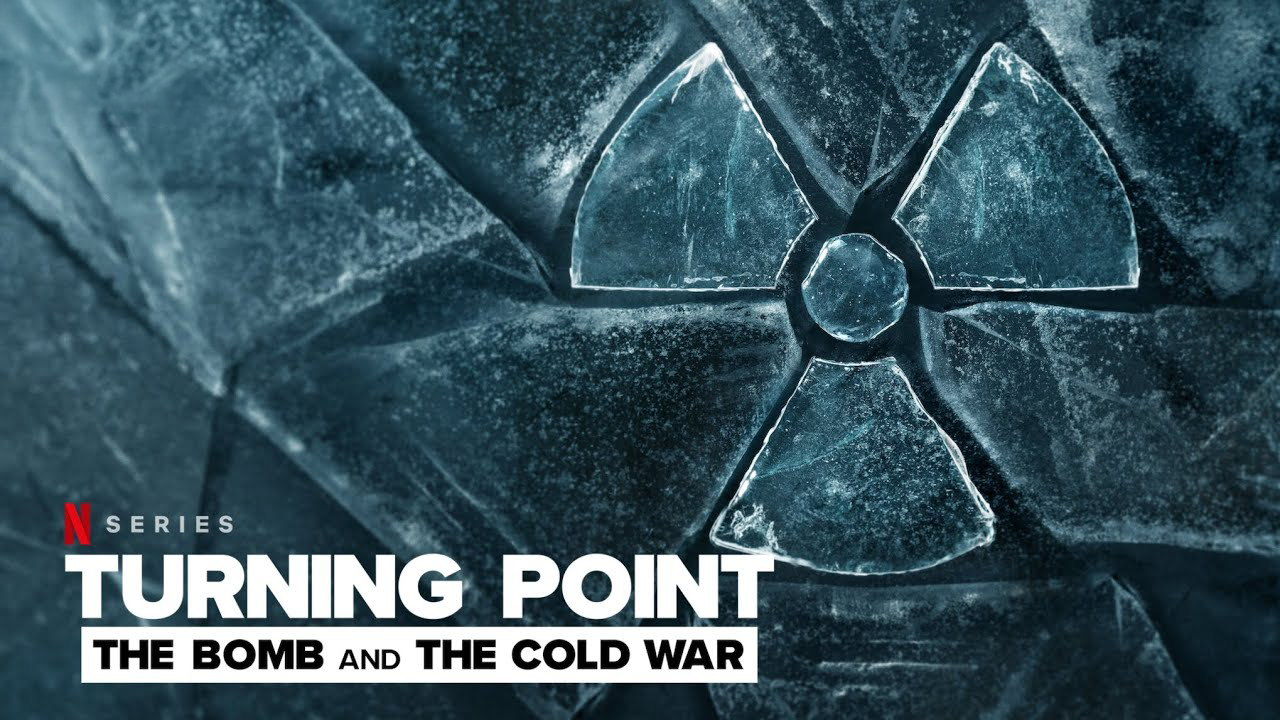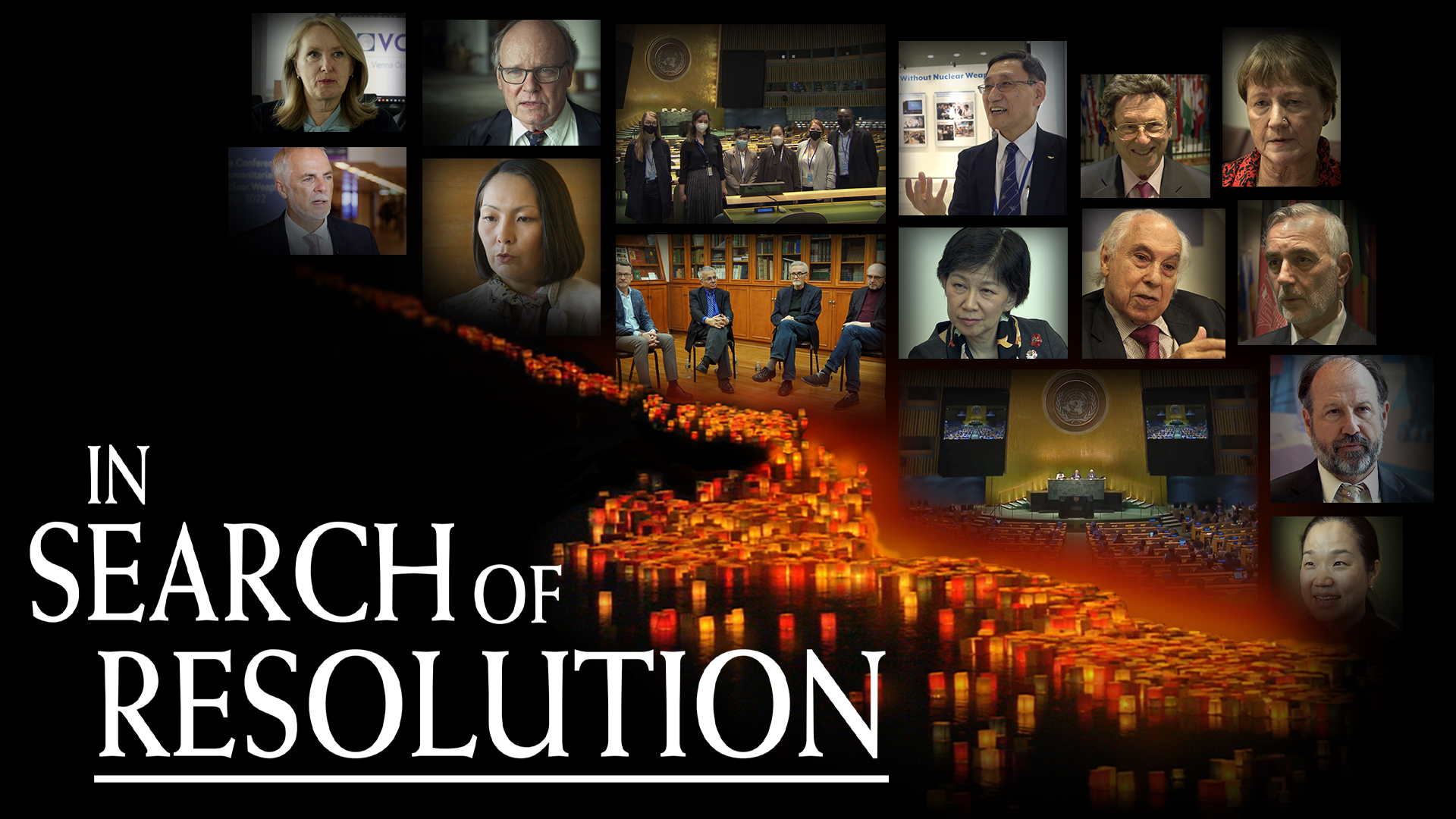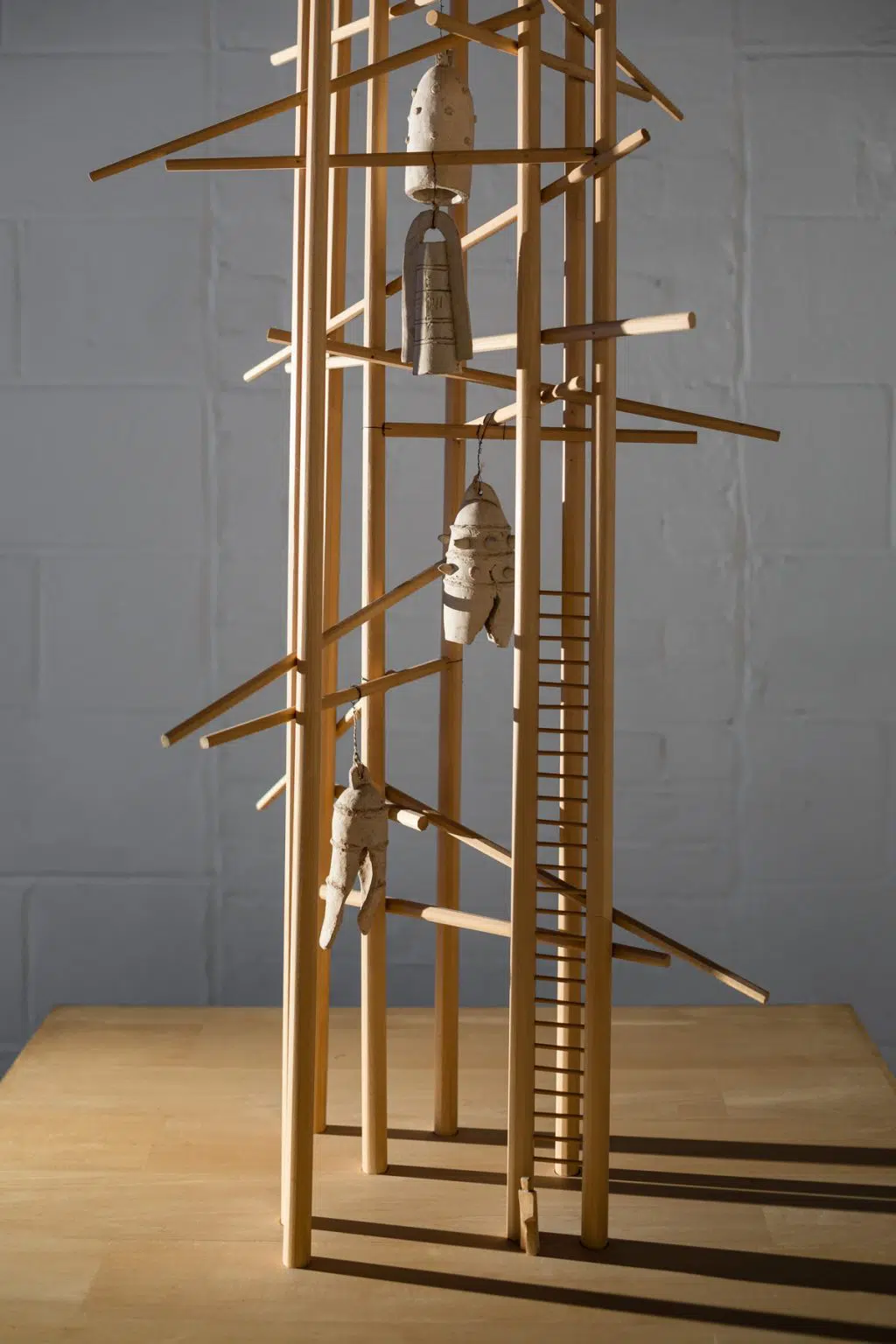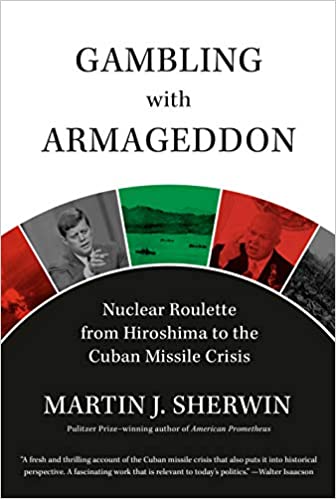Nuclear Media – Recent
A House of Dynamite review – Kathryn Bigelow’s nuclear endgame thriller is a terrifying, white-knuckle comeback
★★★★★: Amid a global arms race, ending the threat of nuclear war — and even the testing of nuclear weapons — is imperative, said the Holy See’s diplomat to the United Nations.
By Peter Bradshaw, The Guardian | September 2, 2025 theguardian.com
Kathryn Bigelow has reopened the subject that we all tacitly agree not to discuss or imagine, in the movies or anywhere else: the subject of an actual nuclear strike. It’s the subject which tests narrative forms and thinkability levels.
Maybe this is why we prefer to see it as something for absurdism and satire – a way of not staring into the sun – to remember Kubrick’s (brilliant) black comedy Dr Strangelove, with no fighting in the war room etc, rather than Lumet’s deadly serious Fail Safe.
Time Zero: 05: The Lab (Part 01)
https://964f6bfd-c857-4667-8d59-615efbd0d7c4.libsyn.com/05-the-lab-part-01
”
When the Manhattan Project arrived on the Pajarito Plateau in northern New Mexico, the land was not uninhabited. To establish the highly secretive Site Y, the United States military forcibly removed generations of Nuevomexicano ranchers and blocked regional Indigenous groups from accessing sacred sites. Almost immediately, the lab began detonating massive amounts of explosives, scarring the landscape. Military personnel regularly dumped nuclear waste into local canyon systems that ultimately flowed into the Rio Grande. When World War II came to a close, though, the lab did not.
More than eight decades later, an apocalyptic weapons factory—Los Alamos National Laboratory—still looms over the Pueblos and villages north of Santa Fe. Ninety miles south, Sandia National Laboratory and Kirtland Air Force Base store thousands of nuclear warheads beneath the city of Albuquerque. Both laboratories are expanding in scope and scale.
This week, you’ll hear from Dr. Alicia Romero, curator at the Albuquerque Museum and part of the steering commitee of the Tularosa Basin Downwinders Consortium; Yvonne Montoya, a Nuevomexicana dancer and choreographer; Dr. Myrriah Gómez, a scholar documenting nuclear colonialism in New Mexico; Joni Arends, co-founder and executive director of Concerned Citizens for Nuclear Safety; Archbishop John C Wester, of the Archiocese of Santa Fe; and members of Veterans for Peace.
Learn more, make a donation, or find a text-based version of today’s program at: timezeropod.com.
For a deep dive into the impacts of nuclear colonialism across the state of New Mexico, check out (and bookmark) Nuclear Watch New Mexico.
And visit the website of Tewa Women United to learn more about intersectional justice projects that center northern New Mexico communties.”
TELEVISION EVENT Trailer
Television Event is a documentary that follows the dramatic (and sometimes humorous) making and impact of the film The Day After. The 1983 film played a pivotal role in shifting public consciousness around nuclear weapons and, ultimately, President Reagan’s policies. It’s a reminder on the power of art and storytelling to create meaningful change.
The documentary was also reviewed in The New York Times: https://www.nytimes.com/2025/05/30/movies/the-day-after-documentary-television-event.html
More:
In 2023 a book was publishedd about the making of “The Day After”, read the review in Arms Control Today: https://www.armscontrol.org/act/2024-03/book-reviews/apocalypse-television-how-day-after-helped-end-cold-war
As well as: “‘The Day After’: The Arms Control Association’s Forgotten Role.” <https://www.armscontrol.org/act/2019-03/features/day-after-arms-control-associations-forgotten-role> It is a reminder that a few people can, with some luck and good timing, put big things into motion.
“Turning Point: The Bomb and the Cold War” Explores Impact of US–Soviet Conflict
The nine-part doc examines how two global superpowers have irrevocably altered the course of history.
By Roxanne Fequiere, Netflix | netflix.com
While the the Cold War ended in 1991, even a casual appraisal of current headlines reveals that relations between the United States and Russia — the one-time center of the Soviet Union — remain tense, to say the least. The global repercussions of the Cold War continue to ripple through the current geopolitical landscape to this day, but it can be difficult to understand just how a mid-20th century struggle for ideological dominance continues to ensnare countless nations in ongoing unrest.
In Search of Resolution: Documentary on Nuclear Dangers
“In Search of Resolution,” examines the current state of international nuclear arms control and is the third film of The Nuclear World Project.
Filmed in 2022 after the Russian invasion of Ukraine, this timely documentary examines the continuing dangers posed by the existence of nuclear weapons.
Atomic Days: The Untold Story of the Most Toxic Place in America
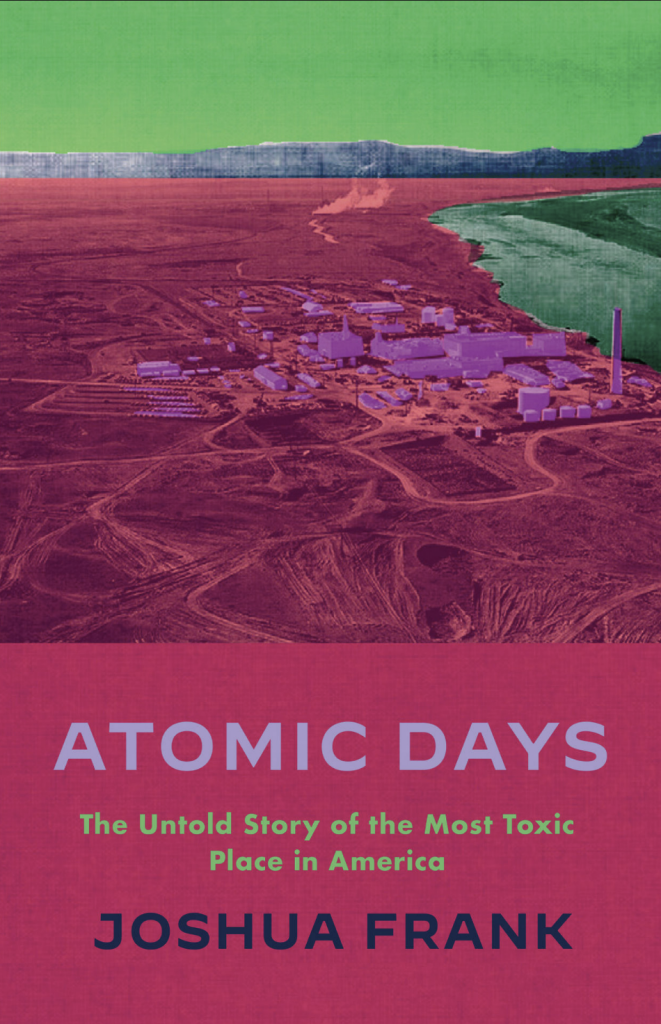
A new book is out about Hanford, by Joshua Frank, co-editor of Counterpunch, Atomic Days: The Untold Story of the Most Toxic Place in America.
Once home to the United States’s largest plutonium production site, the Hanford Nuclear Reservation in Washington state is laced with 56 million gallons of radioactive waste. The threat of an explosive accident at Hanford is all too real—an event that could be more catastrophic than Chernobyl.
Continue reading
The New Mexico Missile that nearly bombed Albuquerque
Tactical Nukes: One Little Nuclear Weapon Can Ruin Your Whole Day
Some people believe smaller nuclear weapons can be used to fight battles. But nuclear weapons are nuclear weapons, and contemplating their use on the battlefield opens the door for full-scale nuclear war.
BBC REEL | Broken Arrows: The accidents that could end the world
On January 23rd, just three days after John. F. Kennedy delivered his inaugural speech as the 35th President of the United States, one little known event could have changed American history in the most catastrophic way imaginable.
A refuelling accident caused a B-52 bomber to break apart above a farm in Goldsboro, North Carolina, causing two 3.8 megaton nuclear bombs to plummet to the ground. Bar one small safety switch and a huge amount of luck, millions could have been killed. Accidents like this are known as ‘Broken Arrows’ and they have happened more than many people realise.
Video by Michal Bialozej
Narration by Dan John
THE BLACK HEROES WHO FOUGHT AGAINST NUCLEAR WAR
Nuclear weapons facilities have been poisoning black and brown communities for decades. For #BlackHistoryMonth , we honor those who fought for saner policies. We need to #StopInvestinginDestruction now. (please share) pic.twitter.com/xoikpDfjZc
— Outrider.org (@OutriderFdn) February 1, 2022
Nuclear Colonialism in the Age of the Ban Treaty January 25, 2022
The Affected Communities Working Group of the Nuclear Ban Treaty Collaborative hosted a discussion marking the one-year anniversary of the entry into force of the nuclear ban treaty on January 25, 2022.
“…That’s how the NRC operates – they want to just run the script and get it done and they’ll answer all your questions “later.” So the next step for us is to go into higher court and see if we can at least get some attention drawn to the very fact that giving them a license is illegal.
The National Waste Policy Act does not allow private organizations to move commercial waste from commercial facilities.
So there’s that problem, and then of course we have to consider that they don’t have all our questions answered yet, like: Who owns the waste? Where is it going to go and who is going to own it? And on the transportation route who is going to own it? And when it gets to the site? There’s no telling, there’s no answer – we don’t know yet. So we have all these questions that haven’t been answered.”
“My question is: Will this #nuclearwaste ever leave? Part of NEPA says that these consolidated interim storage (CIS) sites are temporary. For how long? 30? 40? 50? 100 years? We have to be careful,”
– Rose Garnder with the Alliance for Environmental Strategies in Eunice, New Mexico
Art and “un-forgetting”: How to honor the atomic dead
“The hibakusha narrative has expanded over time to include victims beyond the city limits of Hiroshima and Nagasaki—and as far away as the Navajo Nation, which still suffers the radiation effects of uranium mining; the Marshall Islands, where the United States conducted so many nuclear tests that, on average, the equivalent of 1.6 Hiroshima-size bombs was detonated every day for 12 years; Kazakhstan, where the Soviet Union tested its nuclear weapons for four decades; and other places around the world adversely affected by the development and maintenance of nuclear weapons.”
Noguchi himself considered the term hibakusha to include the victims of nuclear weapons worldwide; he changed the name of his proposed “Memorial to the Dead of Hiroshima” to the more inclusive “Memorial to the Atomic Dead.”
![]() By Molly Hurley | November 26, 2021 thebulletin.org
By Molly Hurley | November 26, 2021 thebulletin.org
As I eagerly await Spotify’s year-end report on my most-played songs of 2021, I wonder which ones will remind me of my summer in New York City—of off-pitch Karaoke Television with friends, or the distinct “popping” sound of a pigeon being run over by a taxi not more than two feet in front of me. Though I thrived amid the frenzied surprises of the city, I also found sudden moments of quiet solemnity while sketching inside the many art museums of the Big Apple. One of those museums was the Noguchi Museum, established in 1985 by its namesake Isamu Noguchi, a Japanese-American sculptor who is also well known for his landscape architecture and modern furniture designs such as the iconic Noguchi table.Continue reading
Newly Released Documentary Film on Santa Susana Field Lab Airing Nationwide Nov. 14 at 10 pm ET
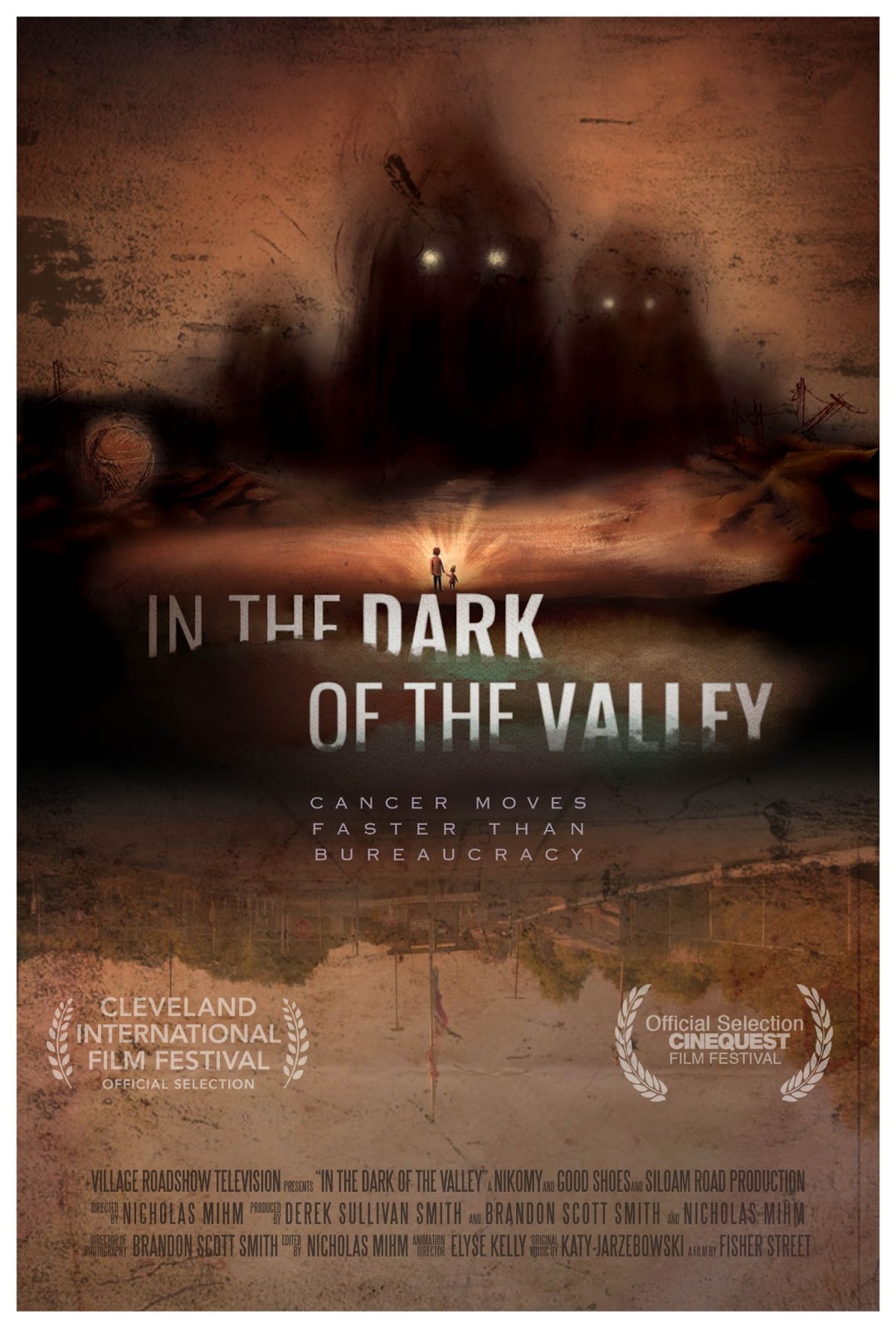
In the Dark of the Valley is the first feature film to focus on the Santa Susana Field Laboratory, a former nuclear and rocket-engine testing site near Los Angeles. The film is an in-depth exploration into the site’s long history of cover-ups and negligence by site owners Boeing, NASA, and the Department of Energy. It also tells the harrowing story of how a community of mothers, led by Melissa Bumstead, have dealt with the struggles of childhood cancer and their new found life of environmental advocacy.
Explosively Entertaining: Nuclear Weapons on TV
Books, Films & Art of Note | Beyond the Bomb: Maria Diaz-Islas, March
1. Jericho (2006-2008)
This show’s passionate fanbase fought tooth and nail to keep it running before CBS canceled it after only two seasons (sounds a lot like some nuclear weapons manufacturers I’ve heard of…). It follows the story of the fictional Kansas town, Jericho, after a nuclear attack on nearby Denver turns the characters’ worlds upside down. The citizens of Jericho struggle as they avoid nuclear fallout, determine how to communicate with the outside world, and try to restore life back to the way it was before the explosion. The post-apocalyptic plot is also riddled with drama, as the characters’ near-death experiences and the loss of loved ones force them to question whether they were truly happy with their former ways of life, reminiscent of living through the COVID-19 pandemic today.
Continue reading
BACK FROM THE BRINK: ENDING NUCLEAR WEAPONS BEFORE THEY END US
Opportunities Under the Biden Administration to Take Action
EVENT VIDEOS AND RESOURCES: Click below to view video recordings, learning resources and actions you can take to eliminate nuclear weapons and the threat of nuclear war.
preventnuclearwar.org/enw-resources
Former Nuclear Watch New Mexico Intern Alicia Sanders-Zakre Presentation on What the Entry into Force of the TPNW Mean in the United States:
The US Intercontinental Ballistic Missile Force: A Post-Cold War INTERACTIVE Timeline
The Pentagon is currently planning to replace its current arsenal of intercontinental ballistic missiles (ICBMs) with a brand-new missile force, known as the Ground Based Strategic Deterrent (GBSD); it is estimated to cost approximately $100 billion in acquisition fees and $264 billion throughout its lifecycle until 2075 (in Then-Year dollars).
Click the link below to find a comprehensive timeline of all relevant actions taken relating to the ICBM force since the end of the Cold War, including force posture alterations, international treaties, congressional efforts, government studies, and milestones in the GBSD acquisition process.
https://web.archive.org/web/20230216030034/https://fas.org/issues/icbm-information-project/timeline-master/
Books
Gambling with Armageddon: Nuclear Roulette from Hiroshima to the Cuban Missile Crisis Hardcover – Deckle Edge, October 13, 2020
From the Pulitzer Prize-winning author of American Prometheus: The Triumph and Tragedy of J. Robert Oppenheimer comes the first effort to set the Cuban Missile Crisis, with its potential for nuclear holocaust, in a wider historical narrative of the Cold War--how such a crisis arose, and why at the very last possible moment it didn't happen.
"Burdens of Proof" — Tim Connor's book on studies that look for links between uncertain exposures and bad health - and why the studies often fail to find clear links.
Doom Towns
 A graphic novel by Andy Kirk with artist Kristian Purcell
A graphic novel by Andy Kirk with artist Kristian Purcell
“The U.S. tested nearly a thousand atomic weapons in the Nevada desert 125 miles north of Las Vegas…. Did they really build fake towns out in the desert and then blow the whole place up with atomic bombs? And the answer is yes, in fact, they did do that…
“The purpose as stated by the civil defense agencies of creating these “Doom Towns” and then widely disseminating on film their being destroyed was to encourage Americans to be concerned about the possibility of civilians being the target of nuclear attack.”
11 ESSENTIAL BOOKS ON NUCLEAR WEAPONS
Staying engaged in the effort to prevent nuclear war requires an understanding of the history of nuclear weapons and the impact their use and production has had on people and the planet. View this list from Ploughshares Fund of some of the best books about nuclear weapons. From well-loved classics to warnings from the past few years, we hope that this selection sheds some light on the need to prevent the spread and further use of nuclear weapons.
Not for the Faint of Heart: Lessons in Courage, Power, and Persistence, Amb. Wendy R. Sherman. The lead negotiator of the Iran nuclear agreement takes readers inside the world of international diplomacy. An autobiography of one of our most effective negotiators — often the only woman in the room. She shows how we can learn to apply core skills of diplomacy to the challenges in our own lives and to the eventual elimination of nuclear weapons.
Thermonuclear Monarchy: Choosing Between Democracy and Doom, Elaine Scarry. Literary critic and social theorist makes the case that the US president’s unchecked power to order a nuclear weapons launch is a violation of the Constitution, and is fundamentally incompatible with the deliberative principles of democracy.
The 2020 Commission Report on the North Korean Nuclear Attacks Against the United States: A Speculative Novel, Jeffrey Lewis. Middlebury College professor, nuclear expert and Ploughshares Fund grantee explores a hypothetical nuclear war involving the United States, North Korea, South Korea and Japan rooted in real historical events, quotes, and facts about nuclear weapons technology. This work of fiction is presented in the style of a report from a government commission charged with investigating the events.
The Doomsday Machine: Confessions of a Nuclear War Planner, Daniel Ellsberg. Former United States military analyst offers his recollections and analysis of a cache of secret documents related to the US nuclear arsenal. The book contains chilling details about narrowly-avoided disasters, flawed launch protocols, and philosophies and strategies regarding the true purpose of the US nuclear arsenal.
My Journey at the Nuclear Brink, William J. Perry. The 19th US Secretary of Defense tells the story of his coming of age during the nuclear era, and reflects on how his experiences over the past 70 years have shaped his thinking about the threat posed by nuclear weapons.
Full Body Burden: Growing Up in the Nuclear Shadow of Rocky Flats, Kristen Iversen. The author, who grew up near the Rocky Flats nuclear weapons facility, presents a detailed account of the government’s efforts to hide the effects of the toxic and radioactive waste released by Rocky Flats, and of local residents’ attempts to seek justice in court.
Command and Control: Nuclear Weapons, the Damascus Accident, and the Illusion of Safety, Eric Schlosser. Acclaimed author and producer explores the history of nuclear weapons systems in the United States. Sobering accounts of nuclear accidents, near misses, and technological developments raise questions about the management and safety of the US nuclear arsenal. Eric Schlosser is a member of the Ploughshares Fund Board of Directors.
African Americans Against the Bomb: Nuclear Weapons, Colonialism, and the Black Freedom Movement, Vincent Intondi. Associate Professor of African-American Studies at Montgomery College chronicles the history of African-American involvement in the nuclear disarmament movement. and explores the connection between nuclear issues and the fight for racial equality.
Arsenals of Folly: The Making of the Nuclear Arms Race, Richard Rhodes. This Pulitzer Prize-winning author chronicles events during the Ronald Reagan administration that led to the US and the Soviet Union coming within minutes of nuclear war, setting the stage for the 1986 summit in Reykjavik, Iceland.
Able Archer 83: The Secret History of the NATO Exercise That Almost Triggered Nuclear War, Nate Jones. National Security Archive staffer writes about a NATO military exercise that the Soviet Union initially mistook for a real nuclear first-strike.
Hiroshima, John Hersey. Required reading for any aspiring journalist, nuclear policy analyst, or anyone interested in the history, this short book collects essays originally published in the New Yorker written about survivors of the atomic bombing of Hiroshima, Japan.
The Button: By William J. Perry and Tom Z. Collina

The President has the power to end the world in minutes. Right now, no one can stop him.
Since the Truman administration, America has been one “push of a button” away from nuclear war—a decision that rests solely in the hands of the President. Without waiting for approval from Congress or even the Secretary of Defense, the President can unleash America’s entire nuclear arsenal.
Almost every governmental process is subject to institutional checks and balances. Why is potential nuclear annihilation the exception to the rule? For decades, glitches and slip-ups have threatened to trigger nuclear winter: misinformation, false alarms, hacked warning systems, or even an unstable President. And a new nuclear arms race has begun, threatening us all. At the height of the Cold War, Russia and the United States each built up arsenals exceeding 30,000 nuclear weapons, armed and ready to destroy each other—despite the fact that just a few hundred are necessary to end life on earth.
From former Secretary of Defense and Stanford professor of international relations William Perry and nuclear policy think-tank director Tom Collina, The Button is a fascinating narrative of our living nuclear history—one in which the players hold the fate of the whole world at their fingertips—and a look at presidential power from Truman to Trump.
1983: Reagan, Andropov, and a World on the Brink
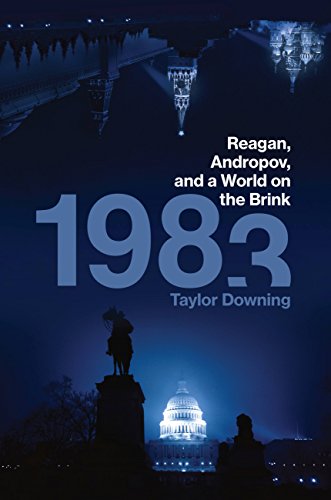 Taylor Downing, Da Capo Press, 4/24/18
Taylor Downing, Da Capo Press, 4/24/18
Recently, a declassified report lifted the veil on the events of a week in November 1983, the year KAL007 was shot down and America watched “The Day After”, when we had in fact, a very close brush with World Death. The Able Archer story is a timely and important reminder of the variety of things that can happen to drive a situation to the brink of nuclear disaster when there is posturing and provocation and no trust.
Excerpts from the Christian Science Monitor book review:
“Able Archer 83 was sparked by a routine NATO military exercise. But, as writer Taylor Downing documents in “1983: Reagan, Andropov and a World on the Brink”, a carefully-researched and absorbing book, it occurred when mistrust and suspicion between the superpowers was sky-high. Indeed, relations were so tense that Soviet political and military leadership believed the exercise was a ruse to enable NATO to launch a pre-emptive strike… The Soviets concluded that this was not an exercise but the real thing and put their own military on the highest readiness level. So fully armed fighter planes sat continuously idling on runways waiting for a signal to take off. Meanwhile, in Washington, nothing seemed amiss. Only much later did the United States realize that Soviet leaders had been petrified with fear. A top-secret US report concluded, “We may have inadvertently placed our relations with the Soviet Union on a hair trigger.” (source: CSM)
More on Able Archer: Slate’s cover story from April 2017:
The Week the World Almost Ended- In 1983, the U.S. simulated a nuclear war with Russia- and narrowly avoided starting a real one. We might not be so lucky next time..
Daniel Ellsberg: The Doomsday Machine: Confessions of a Nuclear War Planner
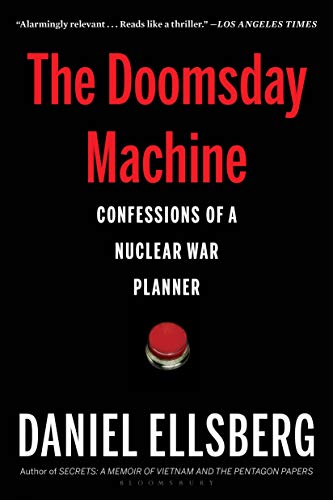 Ron Rosenbaum, in his fascinating and highly readable “How The End Begins” (2011) notes that when Kissinger told Nixon that Ellsberg was “the most dangerous man in America” he wasn’t referring to the Pentagon Papers but to what Ellsberg knew about top secret nuclear war plans from his work at RAND. Ellsberg had also made off with thousands of nuclear war-fighting strategy documents in addition to the Pentagon Papers, but decided to release the latter first. As it turned out much of the nuclear papers were lost during the turmoil following the Pentagon Papers release. This book, long overdue, is about what he learned then.
Ron Rosenbaum, in his fascinating and highly readable “How The End Begins” (2011) notes that when Kissinger told Nixon that Ellsberg was “the most dangerous man in America” he wasn’t referring to the Pentagon Papers but to what Ellsberg knew about top secret nuclear war plans from his work at RAND. Ellsberg had also made off with thousands of nuclear war-fighting strategy documents in addition to the Pentagon Papers, but decided to release the latter first. As it turned out much of the nuclear papers were lost during the turmoil following the Pentagon Papers release. This book, long overdue, is about what he learned then.
Ellsberg recalls being tasked to review the strategic war-fighting plans in effect under Eisenhower, and discovering that they called for “hitting every city, actually every town, above 25,000 population” in Russia and China and to some extent East Europe. Pressed for an estimate of death toll, the pentagon came back with 600 million dead. And that was not counting US and West European death tolls. “I thought, ‘This is the most evil plan that has ever existed. It’s insane.'”
Referring to US and Russian ICBM forces still to this day on alert: “Here is what we now know: the United States and Russia each have an actual Doomsday Machine.”
Democracy Now interview with transcript
Harper’s Magazine excerpt, Dec 6, 2017
The U.S. Sprayed, Injected and Fed Radiation to Countless Innocents in Secret Cold War-Era Testing
 Military scientists exposed American civilians to radiation without their knowledge or consent. “Behind the Fog” documents a dark chapter of “large-scale organizational deviance”…
Military scientists exposed American civilians to radiation without their knowledge or consent. “Behind the Fog” documents a dark chapter of “large-scale organizational deviance”…
From the publisher:
“Martino-Taylor documents the coordinated efforts of a small group of military scientists who advanced a four-pronged secret program of human-subject radiation studies that targeted unsuspecting Americans for Cold War military purposes… Agency and academic partnerships advanced, supported, and concealed the studies from the public at large who ultimately served as unwitting test subjects.
‘They targeted the most vulnerable in society… They targeted children. They targeted pregnant women in Nashville. People who were ill in hospitals. They targeted wards of the state. And they targeted minority populations.’
Martino-Taylor’s comprehensive research illuminates a dark chapter of government secrecy, the military-industrial-academic complex, and large-scale organizational deviance in American history. In its critical approach, Behind the Fog effectively examines the mechanisms that allow large-scale elite deviance to take place in modern society.”
Raven Rock: The Story of the U.S. Government’s Secret Plan to Save Itself – While the Rest of Us Die.
“Raven Rock is this massive, hollowed-out mountain. It’s a free-standing city… with individual buildings, three-story buildings, built inside of this mountain. It has everything that a small city would- there’s a fire department there, there’s a police department, medical facilities, dining halls. The dining facility serves four meals a day, it’s a 24 hour facility, and it was sort of mothballed to a certain extent during the 1990s as the Cold War ended and then was restarted in a hurry after Sept. 11 and has been pretty dramatically expanded over the last 15 years, and today could hold as many as 5,000 people in the event of an emergency.”
Almighty
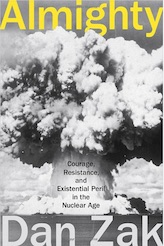 Courage, Resistance, and Existential Peril in the Nuclear Age
Courage, Resistance, and Existential Peril in the Nuclear Age
By Dan Zak, reviewed by Kai Bird
“Zak’s narrative is a perfectly measured blend of biography, suspense and history. He skillfully uses the small, finite story of the Y-12 protest [the break-in 4 years ago by Sister Rice and friends] to explore our national identity as a people whose culture is now intimately connected with things nuclear. Our bomb culture has not come cheap; the environmental costs have been devastating for many communities. And even though scores of governments- but not our own- are on record supporting a treaty that would ban nuclear weapons, Zak shows this is still an outlier dream. He quotes a United States admiral intoning: ‘I don’t see us being nuclear-free in my lifetime. Or in yours.’
We are stuck with Armageddon in our dreams. And in the meantime the Sister Megans of our bomb culture will no doubt try again and again to cry out against our complacency. But truly, it seems hopeless. As Billy Pilgrim laments repeatedly in Kurt Vonnegut’s ‘Slaughterhouse-Five’, ‘So it goes.'”
Interview with Dan Zak, “Almighty” author
A Texas public radio interview with the very knowledgable and thoughtful Dan Zak, author of “Almighty”. Dan discusses The Lieu-Markey bills to restrict presidential authority to launch nuclear war, the B61-12 nuclear bomb and its new capabilities, the planned trillion-dollar “modernization” of the US nuclear arsenal, North Korea, deterrence, and the Oak Ridge Y-12 break-in of 2012.
My Journey at the Nuclear Brink
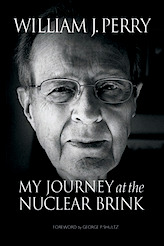 William J. Perry [Former Secretary of Defense]
William J. Perry [Former Secretary of Defense]
Published by Stanford Security Studies, Nov. 2015
Perry argues that nuclear weapons now “endanger our society rather than securing it.” He is one of the founders, along with Sam Nunn, George Schultz, and Henry Kissinger, of the Nuclear Security Project.
In his own words:
“This book is a selective memoir of my experiences with nuclear weapons and nuclear crises, and its purpose is to alert the public to the real and growing dangers of a nuclear catastrophe. I hope you will read this book and learn from it. But I realize that this book, even if effective, will reach only a small audience. In particular, it will reach very few of our young people. The problems I have described are going to be with us for decades, so our young people must play a key role in dealing with them.
Therefore I have undertaken to put these concepts into a form more widely accessible and available to young people. I am doing this through the William J. Perry Project, whose goal is mass education on nuclear dangers… For some years I have taught a course at Stanford about nuclear dangers, and I am now developing that course into an online course that has the potential to reach not just hundreds of students, but hundreds of thousands… The broader series of educational materials under development is called “Nuclear Weapons: 20th-Century History, 21st-Century Decisions,” or 20-21 for short. We not only want people to understand the history, but to engage in current-day issues facing the United States, such as the impending nuclear arms race and the danger of a resumption of nuclear testing.
I hope to encourage young people to take the baton I am trying to pass to them. My generation created this existential problem- their generation must find a way to solve it.”
Los Alamos: A Whistleblower’s Diary

Los Alamos: A Whistleblower’s Diary, by Chuck Montaño, released April 28, 2015. Order your copy from Amazon, or better yet, from the author directly.
“A shocking account of foul play, theft and abuse at our nation’s premier nuclear R&D installation, uncovering a retaliatory culture where those who dare to question pay with their careers and, potentially, their lives.
Tommy was unrecognizable. His face was swollen, bruised, and stained with blood, his eyes barely visible through ballooning eyelids and a broken jaw. On his cheek was a ghostly imprint- the tread mark of someone’s shoe. Suddenly, with a slight movement of his hand, Tommy waved me in closer to hear him. Speaking softly through lips that barely moved, he said, ‘Be careful . . . They kept telling me to keep my fucking mouth shut; they kept telling me to keep my fucking mouth shut,’ he repeated.”
read more excerpts at the book’s website
Radio interview with Chuck Montaño on the book: KSFR Santa Fe.
Chuck Montaño was given the Alliance for Nuclear Accountability’s Whistleblower Award in Washington DC on April 19, 2016.
Films & Video
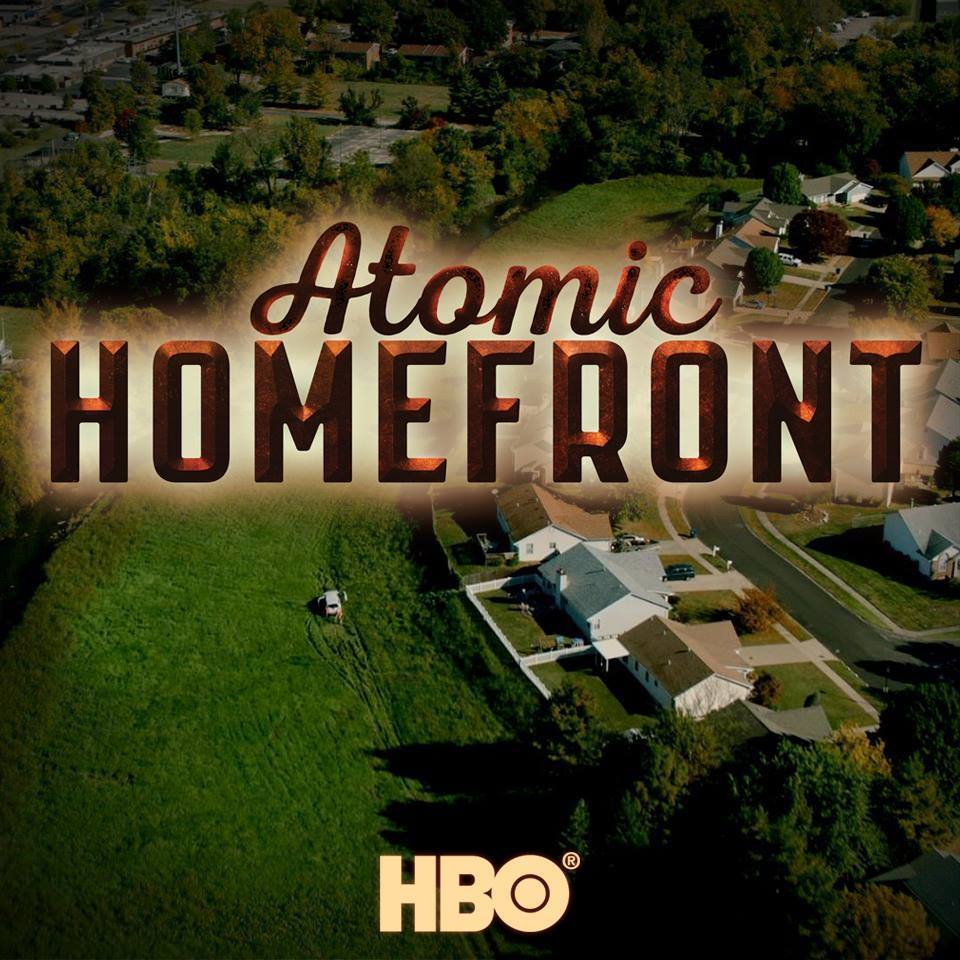
ATOMIC HOMEFRONT
A Documentary Film
By award-winning documentary filmmaker Deborah Cammissa
"The City of St. Louis has a little known nuclear past as a uranium-processing center for the Atomic bomb. Government and corporate negligence led to the dumping of Manhattan Project uranium, thorium, and radium, thus contaminating North St. Louis suburbs, specifically in two communities: those nestled along Coldwater Creek - and in Bridgeton, Missouri adjacent to the West Lake-Bridgeton landfill..."
"To stem the rising tide of nuclear risks in world politics, the ICRC, the International Federation of Red Cross and Red Crescent Societies (IFRC) and the wider International Red Cross and Red Crescent Movement [launched] a global campaign. The video campaign aims to draw further attention of the public to the catastrophic humanitarian consequences of a nuclear war, and ultimately encourage people to urge their governments to sign and ratify the Treaty on the Prohibition of Nuclear Weapons."

